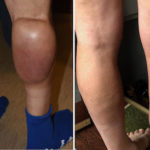Plastic Surgery Case Study – Long-Term Reaction to First Generation Calf Implant Augmentation

Background: Calf implants have been around for over forty years in various forms and shapes. The calf implants we know today are composed of a soft solid silicone material which is designed and manufactured with high quality medical grade technology. Such contemporary silicone materials are not known to undergo significant degradation and/or release degradation byproducts. Read More…



